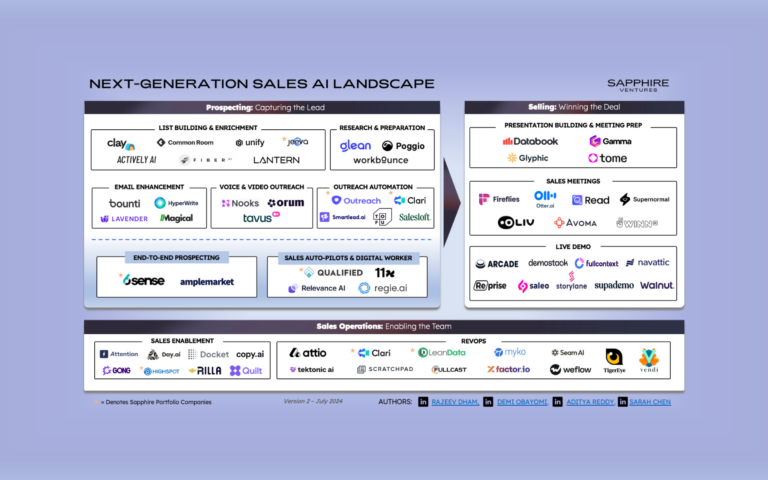In recent decades, many venture capital firms are working to differentiate themselves beyond their ability to write a check. They understand that entrepreneurs’ success isn’t strictly correlated to the size of a funding round; rather, start-ups often need the intelligence, mentorship, and network an experienced VC is able to provide in addition to cash.
Today, value-add teams at VC firms exist in many flavors. Some specialize in engineering support, others center on customer success; still more offer geographical expertise. Sapphire Ventures created its own Portfolio Growth team, which works closely with our entrepreneurs and GPs to help solve their business development, talent, and marketing challenges.
If you’re an entrepreneur with options during fundraising, it can be a challenge to determine which firm is right for you. Any investor can provide financing — and that coveted pattern recognition and broad understanding of your industry matter — but how do you make sure you find a VC with the right operational team to help unlock your company’s real potential? Below are 7 questions every founder should ask about a prospective VC’s value add team to ensure she or he finds the best match.
1. How senior is the team?
Some firms stack their growth teams with junior colleagues and inflated titles. It’s great experience for pre- or post-MBA associates to sit on your board and gain exposure to the start-up process — but this isn’t usually in your best interest. Make sure the value-add team you work with is staffed with senior team members with track records of success.
One particular benefit to working with senior growth partners is access to their Rolodex. When you’re in the middle of rapid growth, the ability to quickly expand your network can be invaluable. For example, if you need to boost sales in a given quarter, you should feel comfortable asking them to introduce you to decision makers at your target accounts. Or, when you’re ready to hire a CXO to augment your team, this is where you should be able to lean on members of your growth team for reputable connections.
Above all, your partners should be experienced startup operators themselves and know what it’s like day to day in the trenches. Otherwise, you’ll be taking advice from people who don’t truly understand the types of problems you’re working through — and who can’t offer the best direction.
2. What is the relationship between the investment team and value-add team?
You want your portfolio growth team to have a direct line of access — and excellent working relationship — with their investment team. Do the two groups show up together to meetings? If they do, are they on the same page, or do they have different agendas? Before the investment closes, does the investment team make an effort to connect you with the growth team for their ideas and advice?
The dynamic between these teams will have a strong impact on your progress. If they’re not aligned, it’s likely you’ll receive mixed messages—which will only make it more confusing and cumbersome to move forward. When speed is imperative, poor teamwork could derail you.
3. What is the structure of the team?
Within the growth team itself, look carefully for cohesion and synergy. Are they simply a bunch of individuals pitching in where they see fit, or do they have set roles and responsibilities that play to their backgrounds and specific strengths? Are they situated under a cohesive leadership structure within the firm and focused on portfolio success, or are they reporting into different investment partners, who may have different agendas, and reduced synergies?
Do the team members complement each other? High-performing teams, even small ones, have a healthy balance of technical and social capabilities—which should play into the range of skills needed to build your company. In addition, understanding your team’s own strengths and weaknesses will help you better select a partner that complements you.
4. How – exactly – will they add value?
You want to be sure that your VC’s growth team takes your company seriously. Indications of their dedication include:
- Delivering specific ideas to you pre-investment
- Symmetry between what you’re looking for and what they offer (e.g., if they pitch their strength in helping with expansion into Asia, but your market is firmly domestic, that’s clearly a mismatch)
- Their availability to meet when you need them — and their ability to follow through on a timely basis
Sapphire’s Portfolio Growth team, for example, is able to provide consistent, extraordinary support to growth stage startups that cater largely to enterprises. We have a global network and deep industry expertise that helps corporate and IT executives keep pace with new trends and find tools that fit their unique needs.
With regards to talent, Sapphire goes well beyond the job board. We’re able to find executives that come in and move the needle. Finally, our team’s European network can help founders looking to access the next frontier in tech.
5. Do they have carried interest?
VCs with carried interest receive a share of the firm’s profits. They are retained by the firm for a longer period of time and have a direct stake in the success of your start-up. If your value-add team partners have carried interest, it is an indicator that will be committed — over and above other members of the firm — to navigating many of the more frustrating aspects of growing a company.
Carried interest can also help you avoid a revolving door of people coming and going from your case. Because the benefit of carried interest is usually reserved for senior partners, it can whittle down your list of potential collaborators to those who are already proven in the start-up ecosystem — eliminating those who are less experienced. We realize it is a sensitive question, but it’s important for you to know they are in it for the long-haul with you.
6. How is their success measured?
Ask your prospective growth team what OKRs/KPIs they rely on — then cross-reference them with your own to ensure they match your success.
At Sapphire, one of our KPIs is 90% referencability from our CEOs. Your success is our success — full stop. If our CEO wouldn’t recommend Sapphire to another entrepreneur, we haven’t been successful.
It’s important to be wary of vanity/effort KPIs, such as the number of introductions made in given month or attendees at meetings — these are not outcome oriented and can confuse activity with effectiveness.
In the end, be sure the investment team and value-add professionals share KPIs. Again, you want to be sure these teams are as aligned as possible to amplify your success.
7. What do references say?
Metrics are essential; however, selecting a value-add team is ultimately personal. When you’re in the midst of rapid expansion, it’s easy to veer off course if you don’t have a solid foundation with your colleagues. Being able to align on values, set expectations, and delegate work streams are the bedrock of hitting any benchmark as a group.
To this end, do your research to determine what CEOs say about a VC’s growth team. Do they — and you — personally know of value-add team members? Do you know them by name? Can you call them? On speed dial? This is the level of access and reputation you should demand if you’re serious about scaling.
Start Your Due Diligence Early
Smart founders know that selecting venture partners begins long before a fundraising deadline. A main reason for this is to be able to test and vet a firm’s value-add capabilities.
CEOs should plan to have a “portfolio” approach to these platforms. As your company ages, your needs will invariably change. At the early phase you may need help with core engineering, UX, or even SDR support. As your business matures, you may find that you need help with other areas, e.g. channel entry, pricing and packaging, or perhaps hiring your COO.
Get to know VCs months or even years in advance of taking their capital. Get a feel for and leverage their platform to be sure it fits your specific needs and phase of growth. As the proverb says, it takes a village! (To raise a child or a successful business.)
Once you’ve done your homework, narrowed your list, and are happy with the valuation and ownership — don’t wait. Solidify the partnership and move forward.
To learn more about how Sapphire Ventures approaches value-add services, visit our Portfolio Growth team page.




